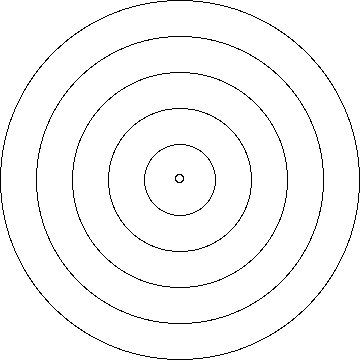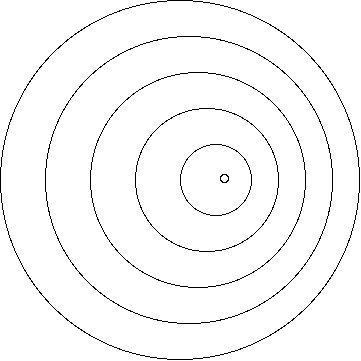
The circles trace regions of maximum compression
in a sound wave.
The radial distance between two circles is the
wavelength.
Doppler Math Root
Consider a stationary sound source producing a
sound with a frequency of f0= 1,000 Hz.
(1000 Hz is 1000 hertz or 1000 cycles per second.)

The circles trace regions of maximum compression
in a sound wave.
The radial distance between two circles is the
wavelength.
Sinusoidal sound waves spread out at mach1, the speed of sound Vs which is about 350 m/s.
The distance between the places of maximum compression in the sound is the wavelength, L.
To produce 1000 Hz the speaker must generate a compression every 1/1000 of a second.
The period of the sound wave is T = 1/f0.
So the sound source produces one compression which rushes away at mach 1 for 0.001 second then it produces a second compression. The distance between these compressions is L = Vs*t = 350 * 0.001 = 0.35 m.
The relationship between the frequency, wavelength and speed of a wave is given by this very useful formula:
Vs = L f
The speed of sound equals the wavelength times the frequency.
When these sound waves travel through still air to a stationary listener they arrive with a wavelength of 0.35 m and a frequency of 1000 Hz.
Things get more interesting when the listener moves or the sound
source moves.
Moving Listener
Let the listener move with speed v toward the sound source.
So the listener is running into the sound waves.
The frequency heard is then f and if the sound source produces a frequency of f0 then
f = f0 (1+v/Vs)
If the listener moves away then the frequency becomes
f = f0(1-v/Vs)
These equations are often written f = f0(1 +- v/Vs) where the second term is read "one plus or minus v/Vs". You have to choose whether to use the plus or minus in the equation.
Notice what happens when the speed of the listener away from the source approaches the speed of sound. The frequency goes to zero. If the listener moves away from the source faster than the speed of sound then the frequency becomes negative, this is not physically meaningful, and so the equation no longer applies.
Interestingly enough the equation still works for approaching the sound source even when the listener moves faster than the speed of sound.
Moving Source
If the source moves toward the listener a wave is sent out but the source moves in the direction of the wave motion so that when the next pulse is emitted the wavelength is shorter.

The wavelength of the sound is given by the equation:
L = L0(1+- v/Vs)
Where the plus or minus must be chosen depending on whether the source is moving towards the listener (minus) or away (plus).
Notice that weird things happen when the source moves toward the listener at the speed of sound. This equation breaks down for sources approaching at mach1 or higher, we'll examine this more in the doppler shift modeling snack.
So using the basic equation relating wavelength and frequency we find
v = Lf so f = v/L
and
f = f0/(1-+v/Vs)
Derive it yourself!
Notice that here there is a division rather than a multiplication.
So the moving source and the moving receiver have two different equations for the perceived frequency.
Now when the speed of the source is small compared to the speed of sound then we can use an approximation.
1/(1+e) = 1 - e when e is small, approximately
thus
1/1.1 = 0.9 approximately
so for small velocities
The frequency heard by the receiver is higher by the same equation as above.
f = f0(1-+v/Vs)
You can then figure out what happens when the source moves away from the listener.
(You can view an animation of the waves spreading
out from a moving source here.
Doppler
animation)
We summarize the above equations by writing f = f0(1+-v/Vs) where the user has to reason out whether to use the + or the - in the equation.
Notice that is v is 10% of Vs then the frequency changes by 10%, this is a very useful shorthand.
For small velocities you can use the relative velocity of the source and the receiver in one equation. However for larger velocities you must use the exact equations and not the approximations.
Doppler challenges
Assume Vs = 350 m/s
1. What is the frequency heard by a stationary observer from a 1000 Hz source moving at 35 m/s toward the observer?
2. What is the frequency heard by an observer moving toward the stationary 1000 Hz sound source at 35 m/s?
3. What is the frequency heard by an observer moving east at 35 m/s toward a 1000 Hz sound source that is moving west at 35 m/s?
4. Repeat the above calculations if the speed in
each case is 315 m/s so that v/Vs = 0.9?
Do you get the same answer for the frequency if you use the relative
velocity of 630 m/s in one Doppler equation with the relative
velocity rather than using two separate equations one for the moving
source and one for the moving listener?
5. A person goes to echo cliff. They drive toward the cliff at 35 m/s blowing the 1000 Hz horn on their car. What frequency do they hear echoing from the cliff?
6. In the exhibit the highest speed is about 20 m/s (measure this yourself) what is the percentage increase in sound frequency as the source approaches you compared to the source at rest? What is the percentage decrease as the source moves away compared to the frequency at rest?
Light
There is also a Doppler shift for light.
Where the speed of light, c, replaces the speed of sound.
However, the equation for the Doppler shift for light includes an extra term due to time dilation in special relativity.
f = f0(1+-v/c)/(1-v^2/c^2)^0.5
Since blue light has higher frequency and red light a lower frequency the Doppler the Doppler shift for light is often called a blue shift if the frequency of the light is increased by the motion of the source toward the receiver and called a red shift if the motion is away.